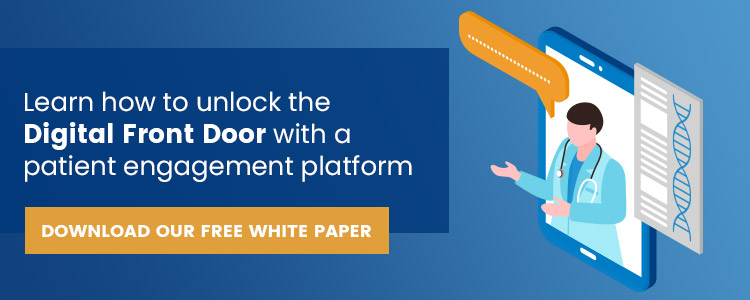The Increasing Importance Of Patient-Reported Outcomes (PROs)
- Kortney Orueta
- September 06, 2023

Patient-centered care has emerged as a cornerstone of modern healthcare, emphasizing the importance of tailoring medical services to individual patients’ unique needs and preferences. Patient-reported outcomes (PROs) have gained increasing recognition as essential tools for healthcare providers seeking to uphold this patient-centric approach. These outcomes reflect patients’ perspectives on their health status and health-related quality of life (HRQoL). They offer crucial insights that enhance clinical decision-making, foster stronger doctor-patient relationships, and improve healthcare outcomes. If you can understand your patients and know what they want, your practice is better positioned to stay effective and competitive.
The FDA defines a PRO as “Any report of the status of patients’ health condition that comes directly from the patient, without interpretation of the patient’s response by a clinician or anyone else” ¹. While the FDA was chiefly concerned with PROs in drug development, they can cover various conditions, from chronic diseases to acute illnesses. PROs are typically collected through surveys, questionnaires, or interviews, but this doesn’t mean you need to take up valuable clinic and hospital time with even more form-filling and paperwork. PROs can be easily completed and processed via digital patient tools like patient portals and healthcare apps. For example, BridgeInteract is an omnichannel patient engagement solution that supports both a branded mobile app and an online portal accessible from any device.
Why Your Patient Platform Needs PROs
The relationship between patients and providers is changing from one in which doctors wielded a distant authority over patients to a more equitable collaboration with shared responsibilities. Modern communication tools empower patients to be more informed about and involved in their health than ever before. At the same time, healthcare providers have an unprecedented opportunity to enhance their medical and business practice with valuable data sourced directly from patients about their needs, the HRQoL impact of treatments, and how happy patients are with the services provided.
PROs allow valuable patient input that is missing from typical metrics. Patients can communicate what truly matters to them, and providers can use PROs to facilitate happier patients, preventative medicine, and value-based care.
What Do PROs Measure?
Patient-reported outcomes encompass a diverse range of information provided directly by patients themselves. This information includes data about symptoms, functional status, psychological well-being, social interactions, and overall quality of life.
PROs are used to measure:
- Severity of symptoms of physical or mental health conditions
- Drug effectiveness
- Post-treatment quality of life
- Patient satisfaction
Unlike traditional clinical measurements that often focus on physiological indicators, e.g., blood pressure or laboratory values, PROs dig deeper into patients’ subjective experiences. These insights offer a more comprehensive understanding of the impact of an illness or treatment on a person’s life–i.e., how has it affected a patient’s daily activities, emotional well-being, and relationships? For example, traditional medical data collection may overlook an intervention that prolongs a patient’s life but also introduces a long-term negative impact such as incontinence, reduced mobility, or intolerable drug side effects. But if you ask patients how these impact their quality of life, they will be eager to highlight what is important to them.
Benefits Of PROs
PROs facilitate a host of processes and initiatives that are crucial to running an effective healthcare operation. Every provider, from individual practices to large hospitals, can make use of PROs to enhance one or more of the following:
Screening And Early Detection/Intervention
PROs can play a crucial role, even at the intake stage, by quickly delivering the patient’s concerns to the provider and allowing the provider to check against population patterns for abnormalities that could be a sign that intervention or further investigation is needed. This can be especially useful in the case of mental health conditions that can be ‘invisible’ to the physician while strongly impacting a patient’s internal life ². For example, the PHQ-9 form for depression can help the clinician make quick decisions about the severity of the patient’s symptoms, assess risks, and proceed with the most effective treatment for their circumstances ³. BridgeInteract offers PHQ-9 and other important screeners as part of its Forms-On-Demand module, empowering healthcare organizations to send standard and customized PRO forms to patients on demand.
Making Data-Driven Decisions
Healthcare decisions are traditionally guided by objective clinical data, but integrating patient-reported outcomes into the decision-making process adds a vital layer of information. By considering the patient’s own perspective, healthcare providers can make more informed and tailored decisions that resonate with the patient’s preferences and values.
For example, in cancer treatment, PROs can help determine the optimal treatment plan based on a patient’s tolerance for side effects and ability to maintain a certain quality of life during treatment. In mental health, PROs can highlight biases and socio-economic factors that a clinician might usually miss ². In orthopedics, PROs can assist in selecting the most suitable surgical approach by gauging the patient’s functional expectations and lifestyle requirements ⁴. These kinds of insights are relevant to all medical specialities and lead to medically effective treatments aligned with the patient’s goals and aspirations.
Patient Engagement And Communication
The integration of patient-reported outcomes not only contributes to improved medical decisions but also enhances the doctor-patient relationship. By actively involving patients in the decision-making process and demonstrating a commitment to understanding their personal experiences, healthcare providers foster a sense of trust and partnership ⁵. A transparent approach allows patients to go into a treatment plan or procedure with a better awareness of how it has impacted the HRQoL of previous patients, and make more informed decisions about the right kind of treatment or clinician for them.
Patients who feel heard and understood are more likely to adhere to treatment plans and communicate openly about their concerns, desires, and symptoms. This collaboration leads to more successful outcomes and stronger patient engagement. Moreover, patients who perceive that their healthcare providers value their quality of life are more likely to experience reduced anxiety and improved emotional well-being, positively influencing their overall health trajectory.
Improving Quality Of Care
The collection and analysis of patient-reported outcomes contribute to advancing healthcare quality and research. Aggregated PRO data enable healthcare institutions to identify patterns and trends, which can guide the development of best practices and targeted interventions under a patient-centered care paradigm ⁶ ⁷. In clinical trials, PROs provide a comprehensive assessment of the efficacy and tolerability of new treatments, serving as valuable endpoints beyond traditional clinical measurements.
Furthermore, PRO data can uncover health disparities and inequities that conventional clinical assessments may overlook. By including diverse patient perspectives, healthcare providers gain a more comprehensive understanding of how specific populations experience healthcare. This facilitates the implementation of more equitable and inclusive practices–a key aim of value-based care ⁸.
Demonstrating Value-Based Care
The US healthcare industry is shifting from the traditional fee-for-service model to one based on value-based care (VBC). This focus on quality over quantity of service entails meticulous record-keeping and reporting on various quality metrics to qualify for government reimbursements. The Centres for Medicare and Medicaid Services is basing reimbursement methods on patient satisfaction scores via the HCAHPS (Hospital Consumer Assessment of Healthcare Providers and Systems) survey, and private insurers have followed suit in tying financial incentives to satisfaction surveys ⁹. Integrating PROs into your workflow will equip you with the data you need to navigate and succeed in VBC reimbursement programs¹⁰.

How To Implement PROs Into Your Practice
With everything that PROs have to offer, they should be implemented appropriately. PROs should be seamlessly integrated with other clinical and patient-facing systems to enhance your practice’s operations without placing additional administrative burdens on staff.
BridgeInteract offers a complete suite of modular, omnichannel patient-facing tools that enable your organization to deploy and utilize PROs in a way that is most effective for your business. For example:
- Bridge Intake – Get the PROs you need right from the start of the patient journey and connect patients with the most appropriate practitioners with robust intake tools that include PRO forms for screening, symptoms, and assessing a patient’s needs from their perspective.
- Bridge Forms On Demand – Easily send patients any form, any time, in seconds from your EHR/PM user interface with Bridge’s Forms On Demand feature. Perfect for sending forms to patients when on the phone, during a walk-in appointment, or handling one-off forms for non-standard situations.
BridgeInteract’s forms are optimized to be as convenient for patients as possible–they work on any device, are available in English and Spanish, and are seamlessly integrated into your overall digital patient ecosystem. Patients can fill out forms online via your patient portal or branded mobile app, providing information on the go, in the comfort of their own homes, or in the waiting room. Results are recorded and accessible via a detailed dashboard that provides analytics that let you see trends and patterns in your patient population to act on the valuable data provided by PROs.
By embracing PROs, healthcare providers empower themselves to make more informed clinical decisions, strengthen doctor-patient relationships, drive healthcare improvements, and advance medical research. To learn more about how BridgeInteract can help your organization make the most of PROs, contact us online to schedule a demo or consultation.
Sources:
- US Food And Drug Administration. (2009). Guidance for Industry, Patient-Reported Outcome Measures: Use in Medical Product Development to Support Labeling Claims. Available at: Guidance for Industry (fda.gov).
- Roe, D., Slade, M., & Jones, N. (2022). The utility of patient‐reported outcome measures in mental health. World Psychiatry, 21(1), 56-57. Available at: The utility of patient‐reported outcome measures in mental health – PMC (nih.gov).
- Pfizer. (2009). The Patient Health Questionnaire (PHQ-9) – Overview. Available at: https://www.ncbi.nlm.nih.gov/pmc/articles/PMC8751576/.
- Lakey, E., & Hunt, K. J. (2019). Patient-Reported Outcomes in Foot and Ankle Orthopedics. Foot & Ankle Orthopaedics. Available at: https://doi.org/10.1177/2473011419852930.
- Li, J., Clouser, J. M., Brock, J., Davis, T., Jack, B., Levine, C., Mays, G. P., Mittman, B., Nguyen, H., Sorra, J., Stromberg, A., Du, G., Dai, C., Adu, A., Vundi, N., & Williams, M. V. (2022). Effects of Different Transitional Care Strategies on Outcomes after Hospital Discharge—Trust Matters, Too. The Joint Commission Journal on Quality and Patient Safety, 48(1), 40-52. Available at: https://doi.org/10.1016/j.jcjq.2021.09.012.
- Basch, E. (2017). Patient-reported outcomes – harnessing patients’ voices to improve clinical care. Massachussetts Medical Society. Available at: https://cdr.lib.unc.edu/concern/articles/zg64tw57r.
- Eriksen, J., Bygholm, A., & Bertelsen, P. (2020). The Purpose of Patient-Reported Outcome (PRO) Post Its Digitalization and Integration into Clinical Practice: An Interdisciplinary Redefinition Resembling PROs Theoretical and Practical Evolvement. Applied Sciences, 10(21), 7507. Available at: https://www.mdpi.com/2076-3417/10/21/7507/htm#B11-applsci-10-07507.
- Ortega, Gezzer MD, MPH, Allar, Benjamin G. MD; et. (2022) Prioritizing Health Equity in Patient-reported Outcome Measurement to Improve Surgical Care. Annals of Surgery 275(3):p 488-491. Available at: https://journals.lww.com/annalsofsurgery/citation/2022/03000/prioritizing_health_equity_in_patient_reported.13.aspx.
- Centres for Medicare and Medicaid Services. (2021). HCAHPS: Patients’ Perspectives of Care Survey. Available at: https://www.cms.gov/Medicare/Quality-Initiatives-Patient-Assessment-Instruments/HospitalQualityInits/HospitalHCAHPS.
- Lyu H, Wick EC, Housman M, Freischlag JA, Makary MA. (2013). Patient Satisfaction as a Possible Indicator of Quality Surgical Care. JAMA Surg. 2013;148(4):362–367. Available at: https://jamanetwork.com/journals/jamasurgery/article-abstract/1679648.